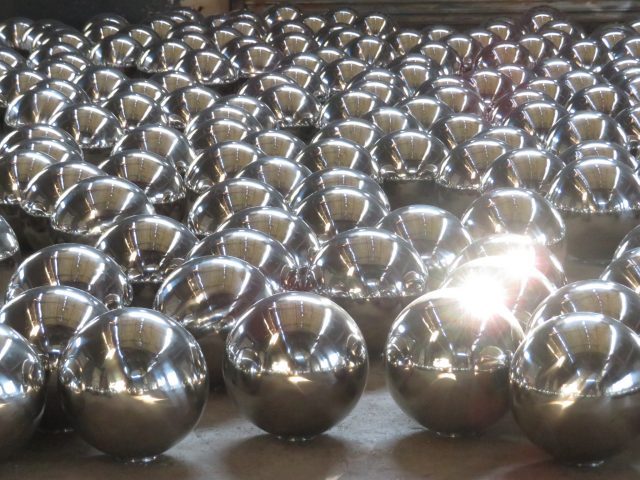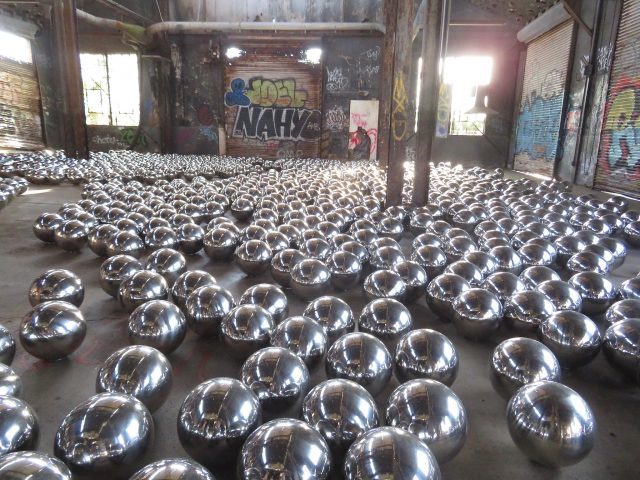
Yayoi Kusama’s silver spheres glitter in Rockaway (photo by twi-ny/mdr)
ROCKAWAY! 2018
MoMA PS1
Gateway National Recreation
Fort Tilden
Friday – Sunday through September 3 (and Labor Day), free, 12 noon – 6:00 pm
www.moma.org
narcissus garden slideshow
In 1966, Japanese artist Yayoi Kusama invited herself to the Venice Biennale, setting up “Narcissus Garden,” a collection of plastic silver spheres, on the lawn outside the Italian Pavilion; she even sold the mirrored balls for about two dollars apiece before being told to stop the vending. Original footage of the intervention is one of the highlights of the excellent new documentary Kusama: Infinity, which opens September 7. In the meantime, visitors can experience “Narcissus Garden” for themselves Friday through Sunday through Labor Day (including that Monday) as part of MoMA’s biannual “Rockaway!,” the free site-specific exhibition started in 2014 by MoMA PS1 curator-at-large Klaus Biesenbach and multidisciplinary artist Patti Smith, both Rockaway residents who were determined to rebuild the area following the devastation wrought by Hurricane Sandy. Kusama, who lived in New York City from 1958 to 1973 and staged many controversial art happenings here, has placed fifteen hundred mirror balls in a former train garage in Fort Tilden in the Gateway National Recreation Area. Kusama’s popularity has risen dramatically this century, with record prices paid for her works and fans lining up for hours and hours (and hours and hours) to get thirty seconds inside one of her Infinity Mirror Rooms at Chelsea’s David Zwirner gallery, for example. So don’t be surprised when you arrive at the Rockaway building only to find that there’s a wait even in the middle of nowhere.

Yayoi Kusama’s 1966 “Narcissus Garden” is reimagined in abandoned Rockaway building (photo by twi-ny/mdr)
“Narcissus Garden” has been displayed around the world over the years, but it is more relevant than ever in the age of social media and selfies. At Venice, Kusama’s installation included a sign that said, “Your Narcisium [sic] for Sale,” and that is very much still true today. The spheres, each of which rests on a small, barely visible stand to keep them from rolling, reflect not only the surrounding area, consisting of other balls, walls covered in colorful graffiti, blown-out windows, and a high, dilapidated ceiling, but the viewer as well. Thus, people snap photos of themselves in the spheres, ready for posting. Others get so caught up in being photographed within the installation that they don’t listen to security guards telling them not to sit on the ground, not to go past the dangling hook, not to touch the pieces, and not to wander down inviting pathways, which are there to tantalize but not follow. There are even some spheres behind a rusted cage, locked away from the rest, segregated as if imprisoned. When we were there, one man muttered about this not being art and actually kicked one of the spheres, causing it to roll away, after which he was ordered to get out, still mumbling as he exited. Thus, “Narcissus Garden,” a presentation of MoMA PS1, the National Park Service, the Jamaica Bay — Rockaway Parks Conservancy, and the Rockaway Artists Alliance, continues to be a reflection of ourselves, now going back more than half a century, although Kusama, an eighty-nine-year-old firm believer in love and peace who still works every single day, is not condemning anyone or criticizing contemporary culture; she just wants us to enjoy the art. And it’s hard not to love it, especially as sunlight filters in and causes one area to suddenly glow.
The balls also are like three-dimensional manifestations of the dots and infinity lights Kusama has been obsessed with since the beginning of her career. “My desire is to measure and to make order of the infinite, unbounded universe from my own position within it, with polka dots,” Kusama said in a 2016 statement for an exhibition at the Glass House in Connecticut. “In exploring this, the single dot is my own life, and I am a single particle amongst billions. — I work with the principal themes of infinity, self-image, and compulsive repetition in objects and forms, such as the steel spheres of ‘Narcissus Garden’ and the mirrored walls I have created.” Don’t get caught up in taking photographs of the installation; instead, experience it for its many wonders, reflecting on your place and the place of others in the universe, contemplating the circularity of life, enjoying the sheer beauty of what is right in front of you. Then snap a bunch of photos and leave, allowing others to come in and get lost in the infinite joy of “Narcissus Garden.” You can then grab a seat and relax as you watch a screening in the main front space of Jud Yalkut’s 1967 seminal counterculture classic, Kusama’s Self-Obliteration.